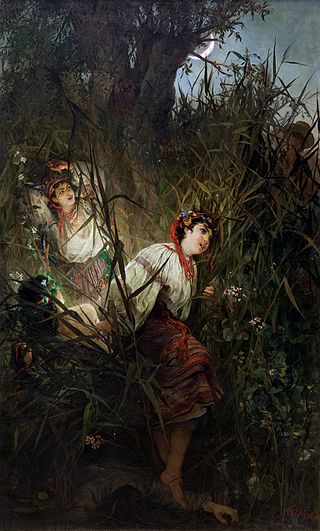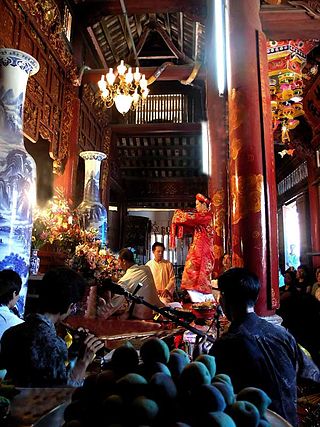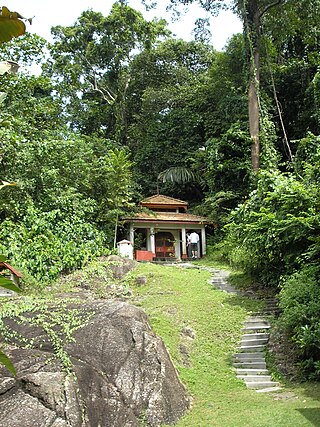
In Slavic mythology, vodyanoy or vodyanoi is a water spirit. In Czech and Slovak fairy tales, it is called vodník, and it is considered to be the equivalent creature as the Wassermann or nix of German fairy tales. In Ukrainian fairy tales, it is called “водяник“ (vodyanik).

Other than the many gods and goddesses of the Slavs, the ancient Slavs believed in and revered many supernatural beings that existed in nature. These supernatural beings in Slavic religion come in various forms, and the same name of any single being can be spelled or transliterated differently according to language and transliteration system.
Suijin is the Shinto god of water in Japanese mythology. The term Suijin refers to the heavenly and earthly manifestations of the benevolent Shinto divinity of water. It also refers to a wide variety of mythological and magical creatures found in lakes, ponds, springs, and wells, including serpents, and the flesh-eating kappa. Mizu no kamisama, Mizugami, or Suijin, is popularly revered and worshipped in temples and continues to influence Japanese culture. Suijin is also known as the water god, Suiten and Sui-ō/Suiu.
Pulau Hantu is located to the south of the main island of Singapore, off the Straits of Singapore. Pulau Hantu is actually made up of two islets: Pulau Hantu Besar and Pulau Hantu Kechil, with a total area of 12.6 hectares. At low tide, it is possible to wade across the shallow lagoon between the two islands, but not at high tide.

A bomoh is a Malay shaman and traditional medicine practitioner. The term is used mainly in Malaysia and parts of Sumatra, whereas most Indonesians use the word dukun. It is often mistranslated into English as medicine man or witch doctor. In colloquial usage, the term bomoh is often interchangeable with another type of shaman or dukun, the pawang, but they generally serve different functions. The bomoh is primarily a healer, herbalist, geomancer, and sorcerer. The pawang on the other hand usually specialises in rituals involving weather, nature, animals, and a good harvest. Their roles do overlap however, and both act as an intermediary for the spirits and gods.
A toyol or tuyul is an undead infant in Indonesian and Malay folklore. It also appears in the various other mythologies of Southeast Asia and is typically invoked as a helper by shamans by means of black magic. A common use for the toyol includes using it for financial gain, where the creature robs people of their riches, making it similar to the Babi ngepet, a boar demon in Indonesian mythology, and the Hantu Raya, a familiar spirit in Malay folklore. As such, the toyol is popularly known to bring good luck to its host, but mishap to those who are unfortunate to encounter them.

The Sama-Bajau include several Austronesian ethnic groups of Maritime Southeast Asia. The name collectively refers to related people who usually call themselves the Sama or Samah ; or are known by the exonym Bajau. They usually live a seaborne lifestyle and use small wooden sailing vessels such as the perahu, djenging (balutu), lepa, and vinta (pilang). Some Sama-Bajau groups native to Sabah are also known for their traditional horse culture.

Hantu is the Malay and Indonesian word for spirit or ghost, sometimes it is also the Tagalog word for ghost. In modern usage it generally means spirits of the dead but has also come to refer to any legendary invisible being, such as demons. In its traditional context the term also referred to animistic nature spirits or ancestral souls. The word is derived from Proto-Malayo-Polynesian *qanitu and Proto-Austronesian *qaNiCu. Cognates in other Austronesian languages include the Micronesian aniti, Lio language nitu, Yami anito, Taivoan alid, Seediq and Atayal utux, Bunun hanitu or hanidu, Polynesian aitu or atua, and Tsou hicu among the Formosan languages. In terms of concept and place in traditional folklore, it is most similar to the Filipino anito.

There are many Malay ghost myths, remnants of old animist beliefs that have been shaped by Hindu-Buddhist cosmology and later Muslim influences, in the modern states of Brunei, Indonesia, Malaysia, Singapore and among the Malay diaspora in neighbouring Southeast Asian countries. The general word for ghost is hantu, of which there exist a wide variety. Some ghost concepts such as the female vampires pontianak and penanggal are shared throughout the region. While traditional belief does not consider all ghosts as necessarily evil, Malaysian popular culture tends to categorise them all as types of evil djinn.
Pelesit is a type of familiar spirit in Malay folklore. It is generally a cricket, or occasionally a grasshopper. The term literally means "buzzer" from the root word lesit meaning to buzz or whizz, as an insect does. They are also called Palasik.

Lên đồng, votive dance, "to mount the medium", or "going into trance") is a ritual practiced in Vietnamese folk religion, in which followers become spirit mediums for various kinds of spirits.

The religious belief of the Datuk Keramat worship can be found in Malaysia, Singapore and along the Strait of Malacca. It is a fusion of Malaysian folk religion, Sufism, and Chinese folk religion in Southeast Asia.

The indigenous religious beliefs of the Tagbanwa people includes the religious beliefs, mythology and superstitions that has shaped the Tagbanwa way of life. It shares certain similarities with that of other ethnic groups in the Philippines, such as in the belief in heaven, hell and the human soul.
The Tajul muluk is common used name for the system of geomancy, comprising metaphysical and geomantic principles considered when siting or designing buildings to improve and maintain well-being in Maritime Southeast Asia. It was traditionally practiced by shamans and architects from Indonesia and Malaysia. The term actually alludes to a book entitled Tajul muluk which covered a number of other topics including herbal medicine, astrology and dream interpretation along with geomancy. While all these subjects may be categorised under the term ilmu tajul, it usually refers to the otherwise unnamed set of rites and rules for constructing buildings in Acehnese and Malay culture.

Malay folklore refers to a series of knowledge, traditions and taboos that have been passed down through many generations in oral, written and symbolic forms among the indigenous populations of Maritime Southeast Asia (Nusantara). They include among others, themes and subject matter related to the indigenous knowledge of the ethnic Malays and related ethnic groups within the region.
Hanitu or qanitu is the Bunun of Taiwan's term for spirit, but it does not exactly equate with terms from other cultures, and is one of three domains of Bunun spiritual thought, another being isang, which equates more to the soul, breath, and heart. It may refer to the spirit of any living creature as well as forms animate or not, such as land, rocks, plants, animals, and humans. All objects contained hanitu. In Malay and Indonesian, the term for ghost, hantu, may be of related origin.

In Indonesia, a fire performance is a group of performance arts or skills that involve the manipulation of fire. Fire performance in Indonesia reflects the country's diversity of ethnicities and cultures. There are more than 1,300 ethnic groups in Indonesia. Each ethnic group has its own performances: there are many fire performance forms in Indonesia. Fire performance has various styles of performance including fire dancing; the use of fire as a finale in an otherwise non-fire performance; and the use of fire skills. Performances can be done as choreographed routines to music.








